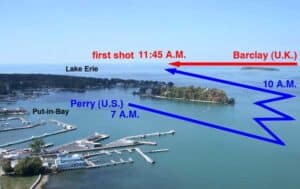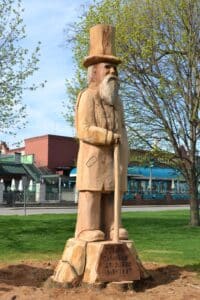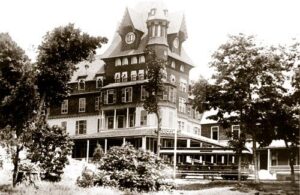Put-in-Bay, Ohio
Put-in-Bay HistoryLearn About The Rich History Of Put-in-Bay!
Put-in-Bay History
Put-in-Bay History From Yesterday To Today.
Put-in-Bay History dates back to the War of 1812 when Put-in-Bay became an important operations headquarters for Oliver Hazard Perry. One of 20 islands located in the shallow western end of Lake Erie, Put-in-Bay harbor served as the launching point from which Perry set sail to defeat the British fleet commanded by Robert H. Barclay in the War of 1812, This historic battle of Lake Erie and the American victory gave the United States Navy and our country the often quoted slogan “We have met the enemy, and they are ours.”
end of Lake Erie, Put-in-Bay harbor served as the launching point from which Perry set sail to defeat the British fleet commanded by Robert H. Barclay in the War of 1812, This historic battle of Lake Erie and the American victory gave the United States Navy and our country the often quoted slogan “We have met the enemy, and they are ours.”
Today at Put-in-Bay, a beautiful Greek Doric column, Perry’s Victory and International Peace Memorial mark the battleground. The peace that came from this historic battle has lasted over 150 years and is commemorated by the 352-foot granite shaft. It perhaps represents the single most recognized part of put in bay history
Three thousand nine hundred eighty-seven miles of border between Canada and the United States is the longest unprotected border frontier in the world today. Put-in-Bay History is re-enacted daily in season at the base of the monument. Guests who visit Put-in-Bay can ride an elevator to the top of the monument to an observation deck offering spectacular views of Detroit, Toledo, and Cleveland skylines on a clear day.
The battleground, which hosted sloops, ships, and brigs with their cannons and long guns, has since been replaced by sleek sailboats and yachts in the downtown Put-in-Bay Docks. In the spring, summer, and fall seasons, pleasure crafts from all around Lake Erie plot their course to Put-in-Bay, Ohio, to enjoy the Put-in-Bay History, which has shaped the island into what it is today.
On any given day, 1000’s of, tourists hop on the Put-in-Bay Ferry for a short ride across Lake Erie to enjoy the many Put-in-Bay attractions, great restaurants, and vibrant nightlife the small Lake Erie Island offers.
The Earliest Visitors In Put-in-Bay History Were The American Indians
Put-in-Bay History shows the earliest visitors were American Indians, evidenced by the many arrowheads, stone axes, and other implements of blue and white flints that are still turned up during construction. When Winter ice conditions allowed the crossing of Lake Erie from the mainland, the American Indians would come to hunt raccoons and other animals.
According to Put-in-Bay History, Louis Jolliet, the French explorer and fur trader, was the first white man to travel on the lake. A group of unidentified explorers sailed among the islands in the summer of 1784. Charts were created of the islands, naming one of them Pudding Bay because the shape of the harbor resembled a pudding bag.
Several Put-in-Bay History log books referred to the harbor as Puden Bay. Connecticut laid claim to the Lake Erie island’s land tracts, then known as the Western Reserve. The French were the earliest white inhabitants to occupy the Lake Erie Islands.
In the summer and fall of 1811, Seth Done arrived with a group of laborers who worked to clear over 110 acres of land to plant wheat and other crops. Soon thereafter, he imported 150 hogs and over 400 sheep, which grazed on an abundance of hickory and acorn nuts found on the island. Soon after this, British Soldiers in the War of 1812 arrived and drove the settlers off the island, destroying crops and livestock.
Put-in-Bay History And The Battle Of Lake Erie
Put-in-Bay History includes numerous tales of battles in the western Lake Erie area and the surrounding land areas; The Americans had suffered several embarrassing defeats at the early start of the war.
In August of 1812, General William Hull attempted to invade Canada, and the mission failed miserably, leading to Detroit’s surrender to the British. In the River Raisin, now known as Monroe, Michigan, General James Winchester, and his forces were soundly defeated in January of 1813.
Later that year, in May and August, Fort Meigs in Perrysburg, Ohio, and Fort Stephenson in Fremont, Ohio, were successfully defended against British and Indian invasions. September 10, 1813, was the turning point in the war.
Oliver Hazard Perry’s victory over the British fleet in the Battle of Lake Erie utilizing the Put-in-Bay Harbor changed the face of the war in a single day. In October 1813, General William Henry Harrison invaded Canada and defeated the Indians and the British at the River Thames.
Put-in-Bay History books document that Oliver Hazard Perry used the harbor as a base of operations. Using the Bass Islands, Sandusky Bay was a short sail for conferences with Harrison or to spy upon the British forces at Fort Malden (Ontario, Canada) in the Detroit River.
When the ships and their men were not engaged in battle, there was plenty to keep them busy. Constant training at the gunnery range and maintaining the ships in battle-ready condition occupied most of the soldier’s time.
On August 12th in 1813, Oliver Hazard Perry sailed the American fleet from Erie, Pennsylvania arriving in the bay of Sandusky, Ohio on August 16th.
While in Sandusky, Perry met with and strategized with American Generals Lewis Cass and Harrison, thus planning the next actions to be taken in the campaign to defeat the British. Commanded by Captain Robert H. Barclay, the British fleet was located off the western horizon by a lookout in the brig Lawrence, Perry’s flagship.
Little did the British command know or expect a hard charge by Perry and the American fleet hidden behind the Bass Islands. Friday, September 10th of 1813, Put-in-Bay History was made. The Lake Erie Battle began at 11:45 in the morning, eight miles northwest of Put-in-Bay, and shortly after 3:00 pm that same day near West Sister Island, the British were defeated, and their control of Lake Erie came to a bloody end.
The entire British fleet of 6 ships was captured. Oliver Hazard Perry scribed on the back of an old letter a note to William Henry Harrison the following:
U.S. Brig Niagara, Off Western Sister Island head of Lake Erie, Sept. 10, 1813, 4 p.m.
Dear General —
We have met the enemy, and they are ours; two ships, two brigs, one schooner, and one sloop.
Yours with great respect and esteem,
O.H. Perry
Put-in-Bay History Post War
Postwar of 1812, the Johnson family lived on Put-in-Bay for three years. Following their settlement on the island came the Hyde family (Henry and Sally), who brought with them 500 sheep. Developer A.P. Edwards brought in laborers and began to develop Put-in-Bay with numerous buildings.
Put-in-Bay History records the first Put-in-Bay Dockage being constructed by John Pierpoint, who later constructed a second dock named the West Dock.
In 1843, Put-in-Bay was home to the first permanent settler Philip Vroman circa 1843. He ivied on the island until his death 68 years later. From the downtown Put-in-Bay area today, Gibraltar Island is just across the harbor and, in 1845, was occupied by a contingent of government surveyors who were engaged in making charts of the lake.
According to Put-in-Bay History, Langram Road, as it is now called, was then referred to as a “sight” road as the surveyors found it necessary to cut a 45-foot swath of trees in a straight-like to “sight” the survey instruments correctly.
Jose DeRivera Shaped Many Aspects Of Modern Put-in-Bay History
Put-in-Bay History was perhaps most notably shaped when in 1854, Joseph De Rivera, a Spanish merchant, bought the Bass Islands, including South Bass (Put-in-Bay Ohio) Middle Bass, Sugar Island, Gibraltar, Ballast, and Stave Island, for $44,000. He developed the island, first building a stave mill and a sawmill in the fall of 1854.
Bass, Sugar Island, Gibraltar, Ballast, and Stave Island, for $44,000. He developed the island, first building a stave mill and a sawmill in the fall of 1854.
De Rivera hired an engineer to survey the area and began to form 10-acre parcels. Forty-two of these parcels were sold in the first ten years on the South and Middle Bass Islands.
The current-day downtown park at Put-in-Bay is aptly named De Rivera Park in his honor. To this day, a trust manages the park to preserve his wishes.
His generosity again impacted Put-in-Bay History when, for the sum of $1.00, he sold the South Bass Board of Education a quarter of an acre for the construction of Put-In-Bay’s first school.
Wine Production Was An Important Part Of Put-in-Bay History
Throughout the 1850s, the Islands continued to develop. The grape-growing and wine-making industry began in the Lake Erie Islands. Put-In-Bay’s attraction as a historical island resort was being developed. In 1852, 1858, and 1859 large celebrations were held to honor Oliver Hazard Perry’s victory over the British in 1813.
The Bass islands, particularly Put-in-Bay, had become well known for the excellent wines made from an extended growing season for island grapes.
Farmers recognized the rich soil and warm temperatures extended by the breeze across the Lake Erie waters, and many came to the island to plant vineyards and become active in resort-oriented businesses.
By the 1860s, over 500 persons called Put-in-Bay their permanent residence. Put-in-Bay History books document a story that appeared in the Sandusky Daily Register, which ran in 1866 and documented some rather interesting statistics. According to the article, the once uninhabited island was now home to 165 cattle, 103 horses, 206 hogs, and one lone mule.
Farmers harvested bountiful crops of wheat, rye, barley, potatoes, hay, clover, sorghum, buckwheat, and oats. An additional 72 acres of Put-in-Bay was now planted with vines bringing the total to 422 acres. In 1865, the Put-in-Bay grape harvest totaled 1,117,801 pounds, yielding 33,805 gallons of wine!
As the island continued to grow, Put-in-Bay History documented the first Local island government in 1861. John Stone, Simon Fox, and others from the three Bass Islands petitioned the Ottawa County commissioners for permission to organize Put-in-Bay township.
On June 22, 1861, the electors selected their town trustees. Fifteen years later, In May of 1876, after the three islands were organized as a township, a portion of South Bass was incorporated as the Village of Put-in-Bay, which we now refer to as downtown Put-in-Bay Ohio.
In 1865 De Rivera again demonstrated his generosity by donating land for St. Paul’s Episcopal Church Mother of Sorrows Roman Catholic Church, which was established in 1866.
The Put-in-Bay Telegraph Company was incorporated in 1873, with a two and seven-eighth-mile cable between Catawba Point and South Bass Island. In the 1930s, dial phones replaced old hand-cranked wall instruments. In May 1906, the street lighting system was converted to electricity.
The 1850s Begin The History of Tourism At Put-in-Bay
From the 1850s to the 1900s, numerous steamships, including several holding upwards of 1,500 passengers, included Put-in-Bay as a regular stop. Hotels were constructed for the tourists, and many were treated to the largest, the Hotel Victory, a 300 x 600 foot with 625 guest rooms. At the time, the Hotel Victory was the largest hotel in America, with the first-ever coed swimming pool. When the cornerstone for the Hotel Victory was laid, Seven Steamboats brought over 8000 people to Put-in-Bay.
constructed for the tourists, and many were treated to the largest, the Hotel Victory, a 300 x 600 foot with 625 guest rooms. At the time, the Hotel Victory was the largest hotel in America, with the first-ever coed swimming pool. When the cornerstone for the Hotel Victory was laid, Seven Steamboats brought over 8000 people to Put-in-Bay.
Another noteworthy hotel was the Beebe House, with a vast hall 500 feet thru the center and a dining room seating 1000 people. Before being able to be fully utilized, the Hotel Victory burned to the ground in a blaze, according to Put-in-Bay History, by a fire that could be seen from Cleveland.
For over 100 years, Put-in-Bay, Ohio, has attracted tourists to a quaint but vibrant resort island. Today, over one million tourists annually enjoy the eclectic makeup of fun-filled activities, including fishing, boating, caves, wineries, and a vibrant nightlife. Put-in-Bay Hotels offer travelers comfortable modern accommodations and many with pools and swim-up bars.
The gem of the island, the Put-in-Bay Resort is the island’s newest and largest full-service resort just a block from the downtown nightlife. The Edgewater Hotel was newly remodeled in 2017 and is the only modern hotel directly on the main strip across from the park and Put-in-Bay Docks.
The Bay Lodging Resort has the island’s only indoor-outdoor swimming pool just two blocks from the main area of town. For those seeking more of a rental home type accommodation, the Put-in-Bay Villa Home Rentals offer vacationers four and five-bedroom rentals also just a block from downtown.
For more information on the history of Put-in-Bay History, we suggest you read Isolated Splendor by Robert Dodge, where some of the information for this brief Put-in-Bay History page was obtained. Come to visit South Bass Island or Put-in-Bay as it is better known, and see for yourself!
Be sure to check out the Put-in-Bay Events Schedule! There is almost always a special event happening on South Bass Island!
Travel Tips: Be sure to reserve your Put-in-Bay Golf Cart Rentals Online Here before departing, as cart rentals are frequently sold out! You will receive a confirmation, and your cart will be waiting upon your arrival!
The History Of Put-in-Bay Is Intriguing & Exciting!
American History was changed forever with the historic Battle Of Lake Erie!
Recent Articles From The Put-in-Bay Blog
Things to do in Ohio | Explore the Best Ohio Tourist Attractions
Explore The Many Things To Do In Ohio There are so many attractions and things to do in Ohio! At nearly 45,000 square...
Put-in-Bay 2020
Put-in-Bay 2020 In With The New, Remembering The Old! As we ring in Put-in-Bay 2020, like every year I've lived on the...
News January 2020
Put-in-Bay News January 2020 What's New At The Bay! The Put-in-Bay High School Girl’s Basketball Team returned...
School News January 2020
Put-in-Bay School News January 2020 By Steve Poe, Superintendent “Your greatness is not what you have; it’s what you...
Put-in-Bay News May 2013
Local Put-in-Bay News May 2013 Put in Bay News April was loaded with about everything in the news you could want to...
Put-in-Bay News July 2013
Put-in-Bay News July 2013 Whats Happening On The Island! Put-in-Bay News Reports the Put-in-Bay Restaurants Goat vs....

